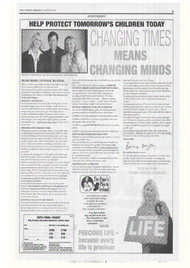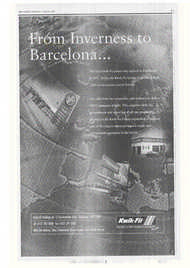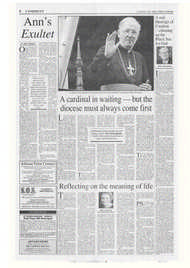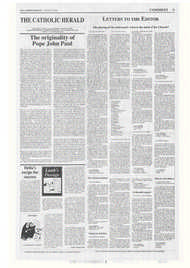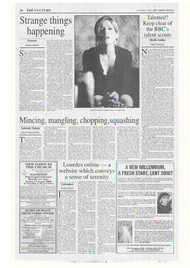Page 12, 31st March 2000
Page 12
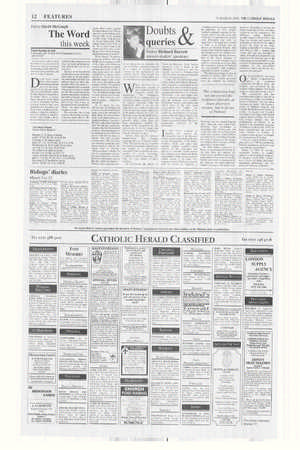
Report an error
Noticed an error on this page?If you've noticed an error in this article please click here to report it.
Tags
Share
Related articles
Doubts
queries
Father Richard Barrett answers readers' questions
In my discussion at university the case of Galileo sometimes crops up as a symbol of scientific genius crushed by the machinery of the Catholic Church. What was the real story behind the Galileo affair and has the Church changed its position?
WHILE SPEAKING tO a Dominican recently I was cautioned for my negativity toward the
Inquisition. The Dominican explained: "It is a common error of our time to judge yesterday's world by today's standards. Take the Inquisition. Were it not for the Inquisition we would not have the office of state prosecutor, which acts in the public interest. for it was the Inquisition that introduced the rule of law and went after the great and powerful where before these had been untouchable. Another byproduct of the Inquisition was the replacement of trial by ordeal with trial by investigation." No apologies from the Dominicans then.
Anyway there are two common interpretations that circulate regarding the case of Galileo (15641642). The first that he was a symbol of scientific knowledge oppressed by the rigours of a prescientific superstition. The second that he was a symbol of infant cosmology smothered by biblical literalism. The truth lies with neither of these positions.
On discovering the phases of Venus in December 1610, Galileo organised a trip to Rome as the champion of Copernicus and was warmly received by Federico Cesi who feted him and inducted him into the Academia dei Lincei.
In May 1611 the intellectual centre of the Jesuits, the Collegio Romano, also arranged a convocation in his honour. Even before the Jesuit party, Galileo was on good terms with the grandee of the Roman curia, Cardinal Bellarmine he had helped him observe the new celestial phenomena that the telescope had revealed. Bellarmine wrote to the Jesuits and asked them if the five main observations of Galileo (the multitude of stars invisible to the naked eye, the roughness of the lunar surface, the odd shape of Saturn, the satellites of Jupiter, the phases or Venus) were well founded. The Jesuit astronomers answered in the affirmative.
IN 1612 WHILE working on sunspots that showed the changeable state of the heavens, Galileo wrote to the Cardinal Prefect of the Congregation of the Index, Cardinal Conti, and asked him whether scripture verified certain features of the philosophy and physics of Aristotle. Conte replied that scripture says nothing about the immutability of the heavens and the orbital motion of the earth. This response spurred Galileo to proceed with his Letters on Sunspots, a
confident and Copernican work that he published in 1613. Galileo claimed scriptural warranty for his system and it was this claim that eventually brought him into conflict with Bellarmine and with the Inquisition. The Inquisition wanted to hold un to Ptolemy and the physics of Aristotle because they assumed that Aristotle's physics was the foundation for his metaphysics. Galileo correctly showed, however, that if the literal meaning of scripture was to be interpreted as a guide to cosmological systems, then the immutable system of Ptolemy was incompatible with scripture, especially the book of Joshua.
The Inquisition began to take an interest in Galileo after 1615. It seems he was initially protected from his enemies by Cardinal
Barberini who was elected Pope in 1623, taking the name Urban VIII. Barberini had established a friendship with Galileo and had written him into some of his poems while still a cardinal. When Galileo was denounced to the Inquisition for his work 11 Saggiatore the charge was simply killed, evidently with the approval of the new Pope.
In 1624 Galileo journeyed to Rome to demonstrate his loyalty to the new Pope and enjoyed six audiences out of which he received a gold medal for his work. Eventually Galileo submitted his manuscript of the Dialogue for papal approval. Galileo's enemies in the papal court, however, succeeded in turning the Pope's mind against him when they suggested that the simpleton in the Dialogue, called Simolicius, actually referred to Pope Urban. The Pope was furious and ordered the distribution of the book to be halted. Despite the anger of the Pope. Galileo, as the light of his times, was still treated with a respect and favour that was not accorded to others. When he was detained by the Inquisition he was not put in the usual dungeon but permitted to stay in a suite of three rooms among the chambers of the prosecutors themselves, had a servant and free access to the courtyard.
N JUNE 23 1633 he was asked to abjure Copernican i sm before an assembled commission. He did so. When his integrity was questioned by his students Galileo replied: "It is worth dying for truth, but not for a fact."
The commission had not interpreted the scriptures literally as many observers today assume but in favour of Ptolemy. The case raises two questions today the dogmatic status of biblical exegesis and whether the Bible teaches truths of science. As regards the Church's official position, when John Paul II came to power as Pope one of the first things ordered was the rehabilitation of Galileo. In an address to the Pontifical Academy of Sciences in November 1979 the Pope acknowledged the need to make amends to Galileo. A commission was set up to investigate the circumstances of his trial.
Later in a visit to Galileo's birth place at Pisa in 1989 he said that the Church's institutions of the time had "imprudently opposed him".
Finally in 1992 he formally exonerated Galileo in another address to the Pontifical Academy of Sciences (31.X.1992). Galileo was a victim of failed patronage, entrenched philosophy and the politics of the court of St Peter.
blog comments powered by Disqus






